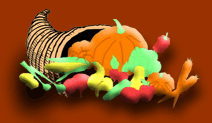Try this idea for a "hanging veggie planter";
Get a 5 gallon bucket or similar container.
Cut or drill several small drain holes in the bottom of the bucket.
Cut a 2 inch (approx.) hole in the side of the bucket about half-way up the side of the bucket.
Fill bucket with good growing soil up to the bottom edge of the hole(s) you cut in the side of the bucket.
Insert your plant (tomato, cuke,etc.) into the hole in the side of the bucket so the plant is on it's side, sticking out
of the bucket.
Make sure you leave a lot of the root and lower stem of the plant inside the bucket so it can take root well inside of
the bucket as it grows out and down.
Carefully fill the bucket up to within a few inches of the top, taking care not to spill the dirt out of the hole where
your plant is sticking out of.
You may want to try put some paper, like a brown bag or tissue, flat over the inside of the hole, to keep the dirt from
spilling out as you fill the bucket.
Now you can hang your plant up and water and feed it like you do your other hanging plants!
The plant or plants will
grow out and down, and you won't have to worry about weeding, or staking the tomato plants.
You can still "sucker"
the plants like normal and fertilize them, but hopefully, you can grow your "veggies" no matter how little space you have,
and enjoy fresh "veggies" right off of your own plants!

